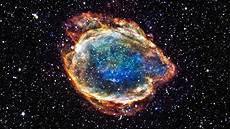Better 'cosmic candles' to illuminate dark energy
 |
| Using a newly identified set of supernovae, researchers have found a way to measure distances in space twice as precisely as before. Photo courtesy of NASA/CXC/U.Texas |
Researchers have more than doubled the precision of a method they use to measure long distances in space—the same one that led to the discovery of dark energy.
In a paper published in Science, researchers from the University of California, Berkeley, SLAC National Accelerator Laboratory, the Harvard-Smithsonian Center for Astrophysics and Lawrence Berkeley National Laboratory explain that the improvement allows them to measure astronomical distances with an uncertainty of less than 4 percent.
The key is a special type of Type Ia supernovae.
Type Ia supernovae are thermonuclear explosions of white dwarfs — the very dense remnants of stars that have burned all of their hydrogen fuel. A Type Ia supernova is believed to be triggered by the merger or interaction of the white dwarf with an orbiting companion star.
"For a couple of weeks, a Type Ia supernova becomes increasingly bright before it begins to fade," says Patrick Kelly, the new study's lead author from the University of California, Berkeley. "It turns out that the rate at which it fades tells us about the absolute brightness of the explosion."
If the absolute brightness of a light source is known, its observed brightness can be used to calculate its distance from the observer. This is similar to a candle, whose light appears fainter the farther away it is. That's why Type Ia supernovae are also referred to as astronomical "standard candles."
The 2011 Nobel Prize in physics went to a trio of scientists who used these standard candles to determine that our universe is expanding at an accelerating rate. Scientists think this is likely caused by an unknown form of energy they call dark energy.
Measurements using these cosmic candles are far from perfect, though. For reasons that are not yet understood, the distances inferred from supernova explosions seem to be systematically linked to the environments the supernovae are located in. For instance, the mass of the host galaxy appears to have an effect of 5 percent.
In the new study, Kelly and his colleagues describe a set of Type Ia supernovae that allow distance measurements that are much less dependent on such factors. Using data from NASA's GALEX satellite, the Sloan Digital Sky Survey and the Kitt Peak National Observatory, they determined that supernovae located in host galaxies that are rich in young stars yield much more precise distances.
Read more
—Manuel Gnida
|